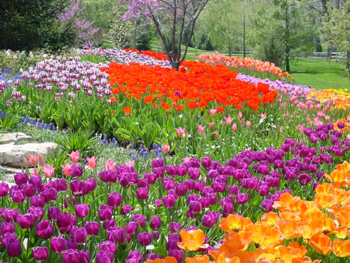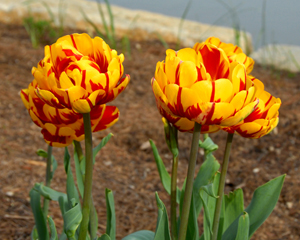How to Plant Tulips
 Hello spring! Nothing marks the arrival of spring more than a planting of cheery and brightly colored tulips. Planted from bulbs in the fall, tulips develop strong roots over the winter months. Once the warmer spring temperatures arrive they are ready to burst forth for a spring show. Tulips are easy to grow as long as you know your goals before planting.
Hello spring! Nothing marks the arrival of spring more than a planting of cheery and brightly colored tulips. Planted from bulbs in the fall, tulips develop strong roots over the winter months. Once the warmer spring temperatures arrive they are ready to burst forth for a spring show. Tulips are easy to grow as long as you know your goals before planting. Perennial plantings
Tulip bulbs planted correctly can become perennials in the garden, returning with flowers each spring. In order to ensure their successful return proper planting must be done to keep the bulbs strong. An issue with tulips in our climate is our short spring season that does not allow the bulbs enough time to build up energy to set a strong flower the following spring. Remember that once the foliage dies down in the late spring next year’s bloom is already forming inside the bulb. For this reason never cut back or remove the foliage until it yellows naturally. Removing foliage reduces energy and the result will be small or no flowers.
Because of our conditions some plantings tend to decline from season to season. The first year each bulb provides a stately bloom. Each following year, as the new bulbs develop, they split, forming smaller bulbs that may not have the same flowering power. Instead of one large flower appearing, two or three smaller blooms will pop out of the ground. Plantings that don’t have enough energy will send up a mass of green foliage and no bloom.
Perennial tulip plantings should be in full sun locations to help the plant get the needed sunlight. The bulbs should be planted deeply about four to six inches from the bottom of the bulb. The soil needs to be well drained to avoid rotting during rainy periods. It would even be a good idea to mix in a generous amount of compost and a little fertilizer when planting to help give them a long-term boost. Each spring when new growth appears it would be beneficial to fertilize with a teaspoon or so of a high nitrogen fertilizer such as 30-0-0. Skip the old out dated recommendation of feeding with bone meal or phosphorus because at this point the goal is to grow healthy green growth to support the bulb.
Annual tulips
 Commercial landscapers treat tulips like annuals. They are removed once done flowering and replaced with annual flowers for a summer of color. The advantage of annual tulips is each year there is the near perfect stand of same height, tall and big flowers to put on the floral display. Removing makes it easy to replant. This approach is working its way into the home landscape.
Commercial landscapers treat tulips like annuals. They are removed once done flowering and replaced with annual flowers for a summer of color. The advantage of annual tulips is each year there is the near perfect stand of same height, tall and big flowers to put on the floral display. Removing makes it easy to replant. This approach is working its way into the home landscape.Instead of thinking of tulips as perennial plants, consider them as disposable at the end of the season just like a pack of petunias, begonias or vinca killed by a fall frost. Your annual beds are easily changed out just like the display in corporate beds.
Planting tulips to be annuals is simpler as their long-term health is not an issue. Planting depths are of little importance. They can be planted a couple of inches deep, just enough to cover the bulbs, protecting them from harsh winter weather and supporting their flowers.
As with any planting soil prep is important. Since tulips are planted shallow, poorly draining soil is less of an issue. Adding organic matter such as compost is always a good idea in locally heavy clay soils to improve the growth of the other plantings in the bed. There is no need to fertilize annual tulips as all the energy this plant needs is already in the bulb when planting. It does not matter whether they are located in a sunny or shady spot.
This concept of an annual planting is not for everyone. Some balk at the cost of the bloom or cannot stand to discard the plant. Bulb size is important as the bigger the bulb the bigger the rewards in regard to size of the flower. It may not hold as true with annual plantings as it depends on your return on investment. Smaller bulbs with smaller flowers that cost less may do the trick with annual planting. It is the mass of color that creates the display, not an individual flower. Using smaller bulbs may not be noticeable and still provide the same impact in the garden.
Fall is the time to add this spring color to the landscape. Whether you chose to plant them as perennials or annuals your home will be ready to say “Hello spring!” when they burst into bloom.

